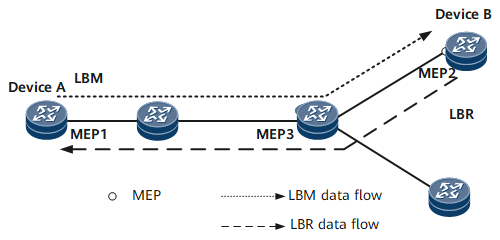MAC Ping Test
Function Overview
NQA MAC ping is an Ethernet OAM tool defined in IEEE 802.1ag. A MAC ping test is performed between a maintenance association end point (MEP) and a maintenance point (MP) to detect network connectivity between the two nodes. The test is initiated by the MEP and the destination node can be either a MEP or a MIP with the same level as the MEP, no matter whether the two nodes are in the same maintenance association (MA).
Test Process
On the network shown in Figure 1, MEP1 on PE1 connects to two remote MEPs: MEP2 on PE2 and MEP3 on PE3. The process of the MAC ping test initiated by MEP1 to MEP2 is as follows:
MEP1 sends a Loopback Message (LBM) to MEP2.
Upon receipt, MEP2 responds with a Loopback Reply (LBR). Based on the LBR, the initiator can calculate the time used by the ping operation to analyze network performance.
Within the specified timeout period:If MEP1 does not receive the LBR returned by MEP2, MEP1 regards that the path between itself and MEP2 is unreachable.
If MEP1 receives the LBR from MEP2, MEP1 calculates the transmission delay between itself and MEP2 based on the timestamps carried in the LBR.
During the test, the initiator can send multiple LBMs continuously and then observe returned LBRs. A MAC ping test can collect Ethernet OAM statistics, including average delay, jitter, and packet loss ratio based on the timestamps carried in packets. These statistics clearly reflect Ethernet performance.
Usage Scenario
MAC ping tests are used in scenarios where multiple MEPs are configured.
Benefits
The Ethernet OAM statistics collected during MAC ping tests, including average delay, jitter, and packet loss ratio, clearly reflect Ethernet performance.
